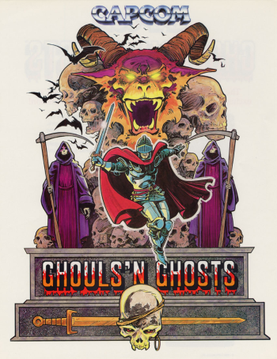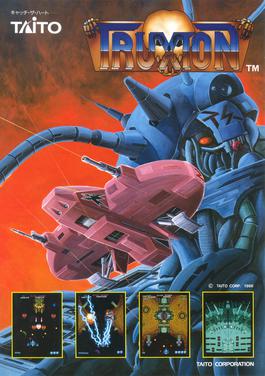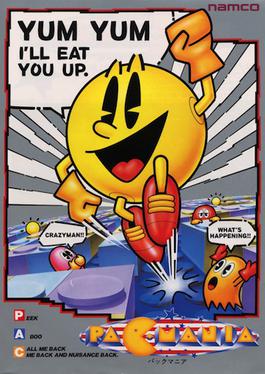
Zero Wing is a 1989 side-scrolling shooter arcade video game developed by Toaplan and originally published in Japan by Namco and in North America by Williams Electronics. Controlling the ZIG space fighter craft, players assume the role of protagonist Trent in a last-ditch effort to overthrow the alien cyborg CATS. It was the eighth shoot 'em up game from Toaplan, and their fourteenth video game overall.

Pole Position is a racing arcade video game released by Namco in 1982. It was licensed to Atari, Inc. for US manufacture and distribution. Pole Position is considered one of the most important titles from the golden age of arcade video games. It was an evolution of Namco's earlier arcade racing electro-mechanical games, notably F-1 (1976), whose designer Sho Osugi worked on Pole Position.

Ghouls 'n Ghosts, known as Dai Makaimura in Japan, is a side-scrolling platform game developed by Capcom, released as an arcade video game in 1988 and ported to home platforms. It is the sequel to Ghosts 'n Goblins and the second game in the Ghosts 'n Goblins series.

Columns is a match-three puzzle video game released by Jay Geertsen in 1989. Designed for the Motorola 68000-based HP 9000 running HP-UX, it was ported to Mac and MS-DOS before being released commercially by Sega who ported it to arcades and then to several Sega consoles. The game was subsequently ported to other home computers, including the Atari ST.
A sports video game is a video game that simulates the practice of sports. Most sports have been recreated with video games, including team sports, track and field, extreme sports, and combat sports. Some games emphasize playing the sport, whilst others emphasize strategy and sport management. Some, such as Need for Speed, Arch Rivals and Punch-Out!!, satirize the sport for comic effect. This genre has been popular throughout the history of video games and is competitive, just like real-world sports. A number of game series feature the names and characteristics of real teams and players, and are updated annually to reflect real-world changes. The sports genre is one of the oldest genres in gaming history.

Truxton is a 1988 vertically scrolling shooter arcade video game originally developed by Toaplan and published in Japan and Europe by Taito, as well as in North America by Midway. Set in a future where the Gidans alien race led by Dogurava invaded the fictional planet Borogo, players assume the role of fighter pilot Tatsuo taking control of the Super Fighter ship on a last-ditch effort to overthrow the alien invaders.

Virtua Racing or V.R. for short, is a Formula One racing video game developed by Sega AM2 and released for arcades in 1992. Virtua Racing was initially a proof-of-concept application for exercising a new 3D graphics platform under development, the "Model 1". The results were so encouraging that Virtua Racing was fully developed into a standalone arcade title.
Michael Jackson's Moonwalker is the name of several video games based on the 1988 Michael Jackson film Moonwalker. Sega developed two beat 'em ups, released in 1990; one released in arcades and another released for the Sega Genesis and Master System consoles. U.S. Gold also published various games for home computers the same year. Each of the games' plots loosely follows the "Smooth Criminal" segment of the film, in which Jackson rescues kidnapped children from the evil Mr. Big, and incorporates synthesized versions of some of the musician's songs. Following Moonwalker, Jackson collaborated with Sega on several other video games.

Hang-On is an arcade racing game released by Sega in 1985 and later ported to the Master System. In the game, the player controls a motorcycle against time and other computer-controlled bikes. It was one of the first arcade games to use 16-bit graphics and uses the Super Scaler arcade system board, created with design input from Yu Suzuki, as technology to simulate 3D effects. The deluxe cabinet version also introduced a motion-controlled arcade cabinet, where the player's body movement on a large motorbike-shaped cabinet corresponds with the player character's movements on screen.

Sega Classics Arcade Collection is the name of two compilations released for the Sega CD. Despite their titles, both versions of Sega Classics Arcade Collection include only the Sega Genesis ports of all the games included.

Rad Mobile is a racing arcade game developed by Sega AM3 and published by Sega. It was first published in Japan in October 1990, followed by an international release for arcades in February 1991. Rad Mobile was Sega's first 32-bit game, using Sega's System 32 arcade system board. It was also the first ever appearance of Sonic the Hedgehog, who appears as an ornament hanging from the driver's rearview mirror.

Kyūkai Dōchūki is a baseball arcade game that was released by Namco in 1990 in Japan; it runs on Namco System 2 hardware, and is a spin-off of Yokai Dochuki. The gameplay is similar to that for Namco's own World Stadium series, except that both players have a total of thirty-six different teams to choose from in the Japanese, Arabic, German, Humbaba, American, Russian, and Chinese leagues. The Japan League has five stadiums, and if the first player selects one team from it, it will randomly decide which one the match will take place in, but the other leagues only have one stadium. This game also features a cameo re-appearance, from Valkyrie, who appears to report the final outcome of a match once it has finished, and Namco's signature character Pac-Man can also be seen on two of the television screens in her studio wearing a purple bow tie.

Final Lap 2 is an racing simulation game released by Namco for arcades in 1990. It is the arcade sequel to Final Lap and runs on Namco System 2 hardware.

Air Buster is a 1990 horizontally scrolling shooter arcade video game developed by Kaneko. It was published by Namco in Japan and Sharp Image Electronics in North America. Two players control the "Blaster Fighter" star ships in their efforts to destroy a mysterious mechanical fortress orbiting Earth, with plans to take control of the planet. The Blaster Fighters can equip one of seven available weapons, which will change the ship's firepower and abilities, such as diagonal shots, homing missiles and small drones that follow the player's ship.

Ayrton Senna's Super Monaco GP II is an arcade-style Formula One racing video game developed and manufactured by Sega for the Sega Genesis and Mega Drive, Master System, and the Game Gear in 1992. It is a follow-up to Super Monaco GP. The game was also endorsed by, and had technical input from, the then-Formula One champion Ayrton Senna. Gameplay includes a World Championship season featuring recreations of the tracks in the 1991 Formula One World Championship, along with a three-race "Senna GP" mode set on fictional tracks.

Super Monaco GP is a Formula One racing simulation video game released by Sega, originally as a Sega X Board arcade game in 1989, followed by ports for multiple video game consoles and home computers in the early 1990s. It is the sequel to the 1979 arcade game Monaco GP. The arcade game consists of one race, the Monaco Grand Prix, but later ports added more courses and game modes based on the 1989 Formula One World Championship.

Pac-Mania is a cavalier perspective maze game that was developed and released by Namco for arcades in 1987. In the game, the player controls Pac-Man as he must eat all of the dots while avoiding the colored ghosts that chase him in the maze. Eating large flashing "Power Pellets" will allow Pac-Man to eat the ghosts for bonus points, which lasts for a short period of time. A new feature to this game allows Pac-Man to jump over the ghosts to evade capture. It is the ninth title in the Pac-Man video game series and was the last one developed for arcades up until the release of Pac-Man Arrangement in 1996. Development was directed by Pac-Man creator Toru Iwatani. It was licensed to Atari Games for release in North America.

Hellfire is a 1989 horizontally scrolling shooter arcade video game originally developed by Toaplan and published in Japan by Taito and North America by U.S.A. Games. The first horizontal shoot 'em up title to be created by Toaplan, the game takes place in the year 2998 where a space matter known as Black Nebula created by robot dictator Super Mech spreads and threatens to engulf human-controlled galaxies, as players assume the role of Space Federation member Captain Lancer taking control of the CNCS1 space fighter craft in a surprise attack to overthrow the enemies with the fighter craft's titular weapon.

Fire Shark is a 1989 vertically scrolling shooter arcade video game developed and published by Toaplan in Japan and Europe, and by Romstar in North America. It is the sequel to Flying Shark, a game released in 1987 on multiple platforms. Set in the year 1991, the game focuses on a mysterious armada launching a worldwide attack from a small island in the Mediterranean Sea. Players take control of the titular biplane to counterattack the enemy forces.

Granada is a shooter video game developed and originally published by Wolf Team exclusively for the X68000 in Japan on 20 April 1990. The ninth title to be created and released by Wolf Team for the X68000 platform, the game is set on a futuristic Africa in 2016 where a war erupted over mining rights towards rare metals and has quickly escalated due to newly-introduced weapons called Maneuver Cepters, as players assume the role of mercenary Leon Todo piloting the titular Maneuver Cepter tank unit in an attempt to stop the conflict once and for all. Its gameplay mainly consists of action and shooting mixed with mission-based exploration using a main two-button configuration.



















